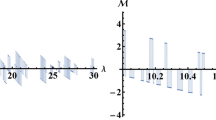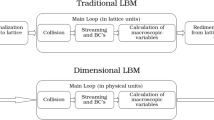Abstract
A new hybrid discrete–continuum numerical approach that explores the key advantages of both discrete and continuum approaches is proposed to model unsaturated seepage flows through porous media. In contrast to existing approaches where a porous medium is often represented by a continuum medium or required a background mesh, the proposed approach explicitly exploits the discrete contact network formed by an assembly of discrete solid particles. Each solid particle is assumed to occupy an equivalent-continuum space, over which the governing equations for unsaturated seepage flow are derived. These governing equations are then discretised and solved on the discrete contact network through a new numerical procedure that links micro-diffusivity to the macro-one. Thanks to this concept, the proposed approach is capable of describing the nature of flow in unsaturated porous media at the microscale level. This unique feature also enables the proposed approach to naturally simulate the water flow through the heterogeneous porous media without any ad hoc treatments. In this paper, the mathematical concept of the proposed approach together with its implementation features and performances for a rigid porous media is presented and discussed. The focus is placed on its application to the discrete element method (DEM), although the proposed concept, in general, can be applied to any other methods possessing similar features.

















Similar content being viewed by others
References
Bui HH, Nguyen GD (2017) A coupled fluid-solid SPH approach to modelling flow through deformable porous media. Int J Solids Struct 125:244–264. https://doi.org/10.1016/j.ijsolstr.2017.06.022
Tran KM, Bui HH, Kodikara J, Sanchez M (2019) Soil curling process and its influencing factors. Can Geotech J. https://doi.org/10.1139/cgj-2018-0489
Tran KM, Bui HH, Sánchez M, Kodikara J (2020) A DEM approach to study desiccation processes in slurry soils. Comput Geotech 120:103448. https://doi.org/10.1016/j.compgeo.2020.103448
Teodosio B, Baduge KSK, Mendis P (2020) Simulating reactive soil and substructure interaction using a simplified hydro-mechanical finite element model dependent on soil saturation, suction and moisture-swelling relationship. Comput Geotech 119:103359. https://doi.org/10.1016/j.compgeo.2019.103359
Hillel D (2003) Introduction to Environmental Soil Physics. Academic Press, Burlington
Teodosio B, Baduge KSK, Mendis P (2020) Relationship between reactive soil movement and footing deflection: A coupled hydro-mechanical finite element modelling perspective. Comput Geotech 126:103720. https://doi.org/10.1016/j.compgeo.2020.103720
Zhou ZQ, Ranjith PG, Yang WM, Shi SS, Wei CC, Li ZH (2019) A new set of scaling relationships for DEM-CFD simulations of fluid–solid coupling problems in saturated and cohesiveless granular soils. Comp Part Mech 6(4):657–669. https://doi.org/10.1007/s40571-019-00246-z
Feddes RA, Kabat P, Van Bakel PJT, Bronswijk JJB, Halbertsma J (1988) Modelling soil water dynamics in the unsaturated zone — State of the art. J Hydrol 100(1):69–111. https://doi.org/10.1016/0022-1694(88)90182-5
Eymard R, Gutnic M, Hilhorst D (1999) The finite volume method for Richards equation. Comput Geosci 3(3):259–294. https://doi.org/10.1023/a:1011547513583
Yamaguchi Y, Takase S, Moriguchi S, Terada K (2020) Solid–liquid coupled material point method for simulation of ground collapse with fluidization. Comp Part Mech 7(2):209–223. https://doi.org/10.1007/s40571-019-00249-w
Song Y, Liu Y, Zhang X (2020) A transport point method for complex flow problems with free surface. Comp Part Mech 7(2):377–391. https://doi.org/10.1007/s40571-019-00282-9
Le TMH, Gallipoli D, Sanchez M, Wheeler SJ (2012) Stochastic analysis of unsaturated seepage through randomly heterogeneous earth embankments. Int J Numer Anal Methods Geomech 36(8):1056–1076. https://doi.org/10.1002/nag.1047
Le TMH, Sanchez M, Gallipoli D, Wheeler S (2019) Probabilistic Study of Rainfall-Triggered Instabilities in Randomly Heterogeneous Unsaturated Finite Slopes. Transp Porous Media 126(1):199–222. https://doi.org/10.1007/s11242-018-1140-0
Zhang D (1998) Numerical solutions to statistical moment equations of groundwater flow in nonstationary, bounded, heterogeneous media. Water Resour Res 34(3):529–538. https://doi.org/10.1029/97wr03607
Dagan G (1993) Higher-order correction of effective permeability of heterogeneous isotropic formations of lognormal conductivity distribution. Transp Porous Media 12(3):279–290. https://doi.org/10.1007/bf00624462
Amir O, Neuman SP (2001) Gaussian Closure of One-Dimensional Unsaturated Flow in Randomly Heterogeneous Soils. Transp Porous Media 44(2):355–383. https://doi.org/10.1023/a:1010706223350
Cundall PA, Strack ODL (1979) A discrete numerical model for granular assemblies. Géotechnique 29(1):47–65. https://doi.org/10.1680/geot.1979.29.1.47
Tran MK, Shin H, Byun Y-H, Lee J-S (2012) Mineral dissolution effects on mechanical strength. Eng Geol 125:26–34. https://doi.org/10.1016/j.enggeo.2011.10.014
Lee J-S, Tran MK, Lee C (2012) Evolution of layered physical properties in soluble mixture: experimental and numerical approaches. Eng Geol 143–144:37–42. https://doi.org/10.1016/j.enggeo.2012.06.008
Tran MK, Byun Y-H, Shin H-S, Lee J-S (2011) Behaviors of soluble granular media during particle dissolution. Int J Geo-Eng 3(2):39–49
Vo T-T (2020) Erosion dynamics of wet particle agglomerates. Comp Part Mech. https://doi.org/10.1007/s40571-020-00357-y
Bayesteh H, Ghasempour T (2019) Role of the location and size of soluble particles in the mechanical behavior of collapsible granular soil: a DEM simulation. Comp Part Mech 6(3):327–341. https://doi.org/10.1007/s40571-018-00216-x
Gan Y, Maggi F, Buscarnera G, Einav I (2013) A particle–water based model for water retention hysteresis. Géotech Lett 3(4):152–161. https://doi.org/10.1680/geolett.13.00046
Zhu F, Zhao J (2020) Multiscale modeling of continuous crushing of granular media: the role of grain microstructure. Comp Part Mech. https://doi.org/10.1007/s40571-020-00355-0
Feng Y, Yuan Z (2020) Discrete element method modeling of granular flow characteristics transition in mixed flow. Comp Part Mech. https://doi.org/10.1007/s40571-019-00309-1
Yang P, Zang M, Zeng H (2020) DEM–FEM simulation of tire–sand interaction based on improved contact model. Comp Part Mech 7(4):629–643. https://doi.org/10.1007/s40571-019-00293-6
Wang J-P, Zeng G-H, Yu H-S (2019) A DEM investigation of water-bridged granular materials at the critical state. Comp Part Mech 6(4):637–655. https://doi.org/10.1007/s40571-019-00243-2
Vo T-T (2020) Rheology and granular texture of viscoinertial simple shear flows. J Rheol 64(5):1133–1145. https://doi.org/10.1122/8.0000033
Tran KM, Bui HH, Kodikara J, Sánchez M (2018) Numerical simulation of soil curling during desiccation process. Paper presented at the the 7th international conference on unsaturated soils, Hong Kong
Gui YL, Hu W, Zhao ZY, Zhu X (2018) Numerical modelling of a field soil desiccation test using a cohesive fracture model with Voronoi tessellations. Acta Geotech 13(1):87–102. https://doi.org/10.1007/s11440-017-0558-9
Zhao G-F (2015) High performance computing and the discrete element model. Elsevier, Amsterdam. https://doi.org/10.1016/B978-1-78548-031-7.50009-6
Itasca (2008) PFC 2D&3D user's manual. Itasca, Minneapolis
Duan K, Kwok CY, Wu W, Jing L (2018) DEM modeling of hydraulic fracturing in permeable rock: influence of viscosity, injection rate and in situ states. Acta Geotech 13(5):1187–1202. https://doi.org/10.1007/s11440-018-0627-8
Shimizu H, Murata S, Ishida T (2011) The distinct element analysis for hydraulic fracturing in hard rock considering fluid viscosity and particle size distribution. Int J Rock Mech Min Sci 48(5):712–727. https://doi.org/10.1016/j.ijrmms.2011.04.013
Prat M (2002) Recent advances in pore-scale models for drying of porous media. Chem Eng J 86(1):153–164. https://doi.org/10.1016/S1385-8947(01)00283-2
Kharaghani A, Metzger T, Tsotsas E (2012) An irregular pore network model for convective drying and resulting damage of particle aggregates. Chem Eng Sci 75:267–278. https://doi.org/10.1016/j.ces.2012.03.038
Yuan C, Chareyre B, Darve F (2018) Deformation and stresses upon drainage of an idealized granular material. Acta Geotech 13(4):961–972. https://doi.org/10.1007/s11440-017-0601-x
Wang H, Anderson M (1995) Introduction to groundwater modeling: finite difference and finite element methods, 1st edn. Academic Press, London
Gili JA, Alonso EE (2002) Microstructural deformation mechanisms of unsaturated granular soils. Int J Numer Anal Methods Geomech 26(5):433–468. https://doi.org/10.1002/nag.206
Mohamed A-MO, Antia HE, Gosine RG (2002) Water flow in unsaturated soils in microgravity environment. J Geotech Geoenviron Eng 128(10):814–823. https://doi.org/10.1061/(ASCE)1090-0241(2002)128:10(814)
Zaidel J, Russo D (1992) Estimation of finite difference interblock conductivities for simulation of infiltration into initially dry soils. Water Resour Res 28(9):2285–2295. https://doi.org/10.1029/92wr00914
Haverkamp R, Vauclin M (1979) A note on estimating finite difference interblock hydraulic conductivity values for transient unsaturated flow problems. Water Resour Res 15(1):181–187. https://doi.org/10.1029/WR015i001p00181
Berg P (1999) Long-term simulation of water movement in soils using mass-conserving procedures. Adv Water Resour 22(5):419–430. https://doi.org/10.1016/S0309-1708(98)00032-3
Lam L, Fredlund DG, Barbour SL (1987) Transient seepage model for saturated–unsaturated soil systems: a geotechnical engineering approach. Can Geotech J 24(4):565–580. https://doi.org/10.1139/t87-071
El-Kadi AI, Ling G (1993) The Courant and Peclet Number criteria for the numerical solution of the Richards Equation. Water Resour Res 29(10):3485–3494. https://doi.org/10.1029/93wr00929
Haverkamp R, Vauclin M, Touma J, Wierenga PJ, Vachaud G (1977) A comparison of numerical simulation models for one-dimensional infiltration. Soil Sci Soc Am J 41(2):285–294. https://doi.org/10.2136/sssaj1977.03615995004100020024x
Zaradny H (1978) Boundary conditions in modelling water flow in unsaturated soils. Soil Sci 125(2):75–82
Celia MA, Bouloutas ET, Zarba RL (1990) A general mass-conservative numerical solution for the unsaturated flow equation. Water Resour Res 26(7):1483–1496. https://doi.org/10.1029/WR026i007p01483
Van Genuchten MT (1980) A closed-form equation for predicting the hydraulic conductivity of unsaturated soils. Soil Sci Soc Am J 44(5):892–898. https://doi.org/10.2136/sssaj1980.03615995004400050002x
Liu K, Vardon PJ, Hicks MA, Arnold P (2017) Combined effect of hysteresis and heterogeneity on the stability of an embankment under transient seepage. Eng Geol 219:140–150. https://doi.org/10.1016/j.enggeo.2016.11.011
Le TMH, Gallipoli D, Sanchez M, Wheeler S (2013) Rainfall-induced differential settlements of foundations on heterogeneous unsaturated soils. Géotechnique 63(15):1346–1355. https://doi.org/10.1680/geot.12.P.181
Parlange J-Y (1971) Theory of water-movement in soils: 2. One-dimensional infiltration. Soil Sci 111(3):170–174
Philip JR (1957) The theory of infiltraiont: 1. The infiltration equation and its solution. Soil Sci 83(5):345–358
Gottardi G, Venutelli M (1993) Richards: Computer program for the numerical simulation of one-dimensional infiltration into unsaturated soil. Comput Geosci 19(9):1239–1266. https://doi.org/10.1016/0098-3004(93)90028-4
Wilson GW, Fredlund DG, Barbour SL (1994) Coupled soil-atmosphere modelling for soil evaporation. Can Geotech J 31(2):151–161. https://doi.org/10.1139/t94-021
Song W-K, Cui Y-J, Tang AM, Ding W-Q, Tran TD (2013) Experimental study on water evaporation from sand using environmental chamber. Can Geotech J 51(2):115–128. https://doi.org/10.1139/cgj-2013-0155
Acknowledgements
Funding support from the Australian Research Council via projects DP160100775 (Ha H. Bui) and DP170103793 & DP190102779 (Ha H. Bui & Giang D. Nguyen) is gratefully acknowledged.
Author information
Authors and Affiliations
Corresponding author
Ethics declarations
Conflict of interest
The authors declare that they have no conflicts of interest.
Additional information
Publisher's Note
Springer Nature remains neutral with regard to jurisdictional claims in published maps and institutional affiliations.
Rights and permissions
About this article
Cite this article
Tran, K.M., Bui, H.H. & Nguyen, G.D. DEM modelling of unsaturated seepage flows through porous media. Comp. Part. Mech. 9, 135–152 (2022). https://doi.org/10.1007/s40571-021-00398-x
Received:
Revised:
Accepted:
Published:
Issue Date:
DOI: https://doi.org/10.1007/s40571-021-00398-x




